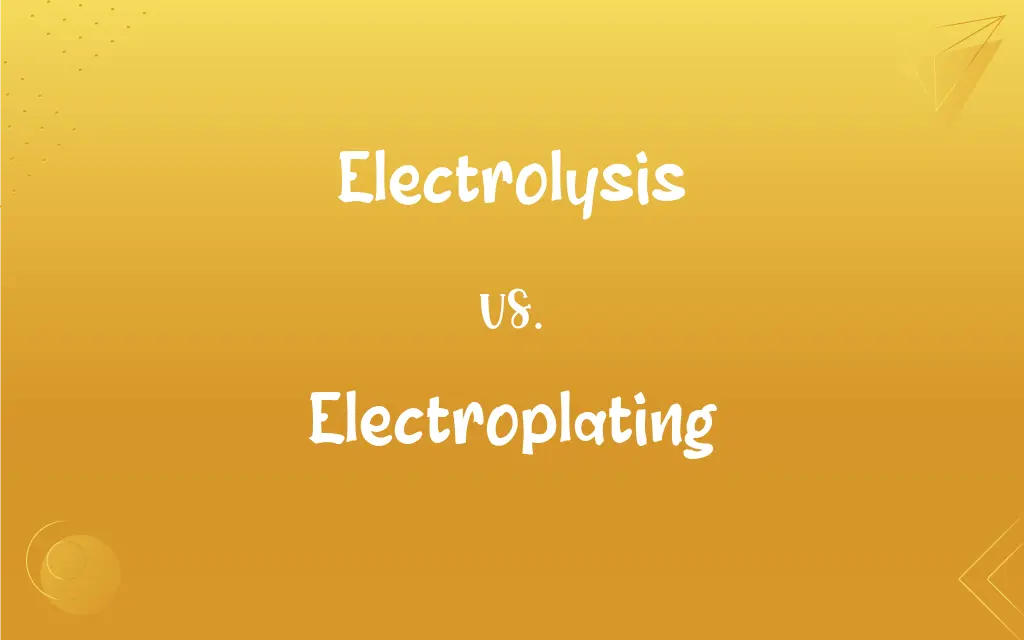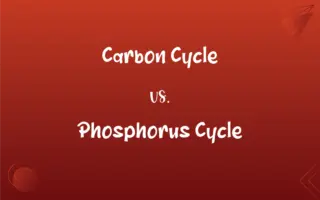Electrolysis vs. Electroplating: What's the Difference?
Edited by Janet White || By Harlon Moss || Updated on October 21, 2023
Electrolysis involves breaking down a substance using electricity, while electroplating deposits a metal layer onto an object using an electric current.

Key Differences
Electrolysis is a broad chemical process in which an electric current drives a non-spontaneous reaction. This means reactions that wouldn't ordinarily happen can occur due to the supplied electricity. On the contrary, electroplating is a specific application of electrolysis where a metal surface is coated with another metal to enhance its properties.
Electrolysis can serve various purposes, such as splitting water into hydrogen and oxygen or extracting metals from their ores. Electroplating, however, primarily focuses on depositing a thin layer of metal onto a substrate, often to improve the substrate's appearance, reduce corrosion, or achieve other desired characteristics.
The applications of electrolysis extend to medical realms, like hair removal, or environmental applications, like desalination. In contrast, electroplating mainly finds its utility in industries like jewelry manufacturing, electronics, and automotive parts production.
The fundamental principle of electrolysis involves the movement of ions in a solution upon the application of an electric current, resulting in chemical changes. Electroplating employs this principle specifically to reduce cations of a desired metal from a solution, depositing them onto an electrode.
To understand both terms deeply, one must recognize that while all electroplating is electrolysis, not all electrolysis is electroplating. Electroplating is a subset of the broader range of applications and reactions encompassed by electrolysis.
ADVERTISEMENT
Comparison Chart
Definition
Breaking down of substances using electricity
Depositing metal onto a surface using electricity
Application
Diverse chemical processes
Specific to metal coating
Purpose
To drive non-spontaneous reactions
Improve appearance, reduce corrosion, etc.
Example
Splitting water into hydrogen and oxygen
Gold-plating jewelry
Outcome
Various chemical products
Metal-coated object
ADVERTISEMENT
Electrolysis and Electroplating Definitions
Electrolysis
A process used for refining metals or producing chemical products.
Electrolytic cells in the industry utilize electrolysis for metal extraction.
Electroplating
An application of electrolysis to enhance the properties of a material.
To prevent rust, the components underwent electroplating.
Electrolysis
A method to drive non-spontaneous chemical reactions using electricity.
Through electrolysis, water can be split into oxygen and hydrogen.
Electroplating
A method used in industries to improve electrical conductivity or reduce friction.
The connectors, after electroplating, had improved electrical characteristics.
Electrolysis
The decomposition of a substance by passing an electric current through it.
They achieved the breakdown of the compound using electrolysis.
Electroplating
The practice of using an electrolytic cell to deposit metal ions onto a substrate.
Electroplating of silver onto the base metal gave it an attractive appearance.
Electrolysis
The removal of hair roots or small blemishes on the skin by burning them with an electrically heated needle.
She opted for electrolysis to remove unwanted facial hair permanently.
Electroplating
The process of depositing a thin layer of metal onto another metal by electrolysis.
The ring was gold, achieved through electroplating.
Electrolysis
A technique used in the separation of elements or ions from a compound.
Electrolysis efficiently isolated the desired element from the mixture.
Electroplating
A technique to coat objects with a protective or decorative layer.
Electroplating gave the jewelry a bright and shiny finish.
Electrolysis
Chemical change, especially decomposition, produced in an electrolyte by an electric current.
Electroplating
To coat or cover with a thin layer of metal by electrodeposition.
Electroplating
Present participle of electroplate
Electroplating
A process of coating the surfaces of a metal object with a layer of a different metal through electrochemical means, usually to exploit different properties of the materials.
Electroplating
The art or process of depositing a coating (commonly) of silver, gold, or nickel on an inferior metal, by means of an electric current. The metal to be deposited on an article is usually used as the anode and the article to be plated as the cathode, in an electrolyte solution in which the plating metal is the cation. The process is conducted in a tank called an electroplating bath, which holds the electrolyte solution.
FAQs
What is electrolysis?
Electrolysis is the breakdown of a substance using electric current.
How is electrolysis used in daily life?
Electrolysis is used in hair removal, water splitting, and metal extraction.
Can electrolysis be used for water purification?
Yes, electrolysis can break down contaminants in water, though it's not the primary method for purification.
How is electrolysis used in the production of chlorine?
Electrolysis of salt solution (brine) produces chlorine gas at the anode.
Are there any alternatives to electroplating in the industry?
Yes, processes like physical vapor deposition (PVD) and chemical vapor deposition (CVD) can be alternatives.
What's the principle behind electrolysis?
Electrolysis involves using an electric current to drive a non-spontaneous chemical reaction.
Can electrolysis be used for energy storage?
Yes, for example, in producing hydrogen for fuel cells.
What benefits does electroplating offer to industrial components?
Electroplating can reduce corrosion, improve conductivity, and enhance appearance.
Is the electrolysis of water safe?
Yes, when done correctly, but it produces hydrogen, which is flammable.
What are the environmental impacts of electroplating?
Electroplating can produce toxic wastewater, which needs proper treatment.
What are the safety concerns associated with electroplating?
Toxic chemicals, fumes, and electrical hazards can pose risks during electroplating.
Why is electroplating important in jewelry manufacturing?
Electroplating can improve appearance, prevent tarnishing, and add value.
What metals are commonly used in electroplating?
Gold, silver, nickel, and chrome are frequently used in electroplating.
Why might electroplating be used on cookware?
Electroplating can provide a non-reactive, non-stick, or decorative surface.
Is electrolysis reversible?
While the process itself can be reversed, the products may not always return to their original state.
What is electroplating?
Electroplating is the process of coating an object with a thin layer of metal using electricity.
How long does the electroplating process typically take?
It varies, but can range from minutes to several hours depending on the object and desired thickness.
Is the process of electrolysis energy-intensive?
Yes, it requires a continuous supply of electric current.
Can any metal be used for electroplating?
While many metals can be electroplated, some are more suitable due to adherence, appearance, and corrosion resistance.
What's the role of an electrolyte in electrolysis?
It facilitates the movement of ions, allowing electric current to pass.
About Author
Written by
Harlon MossHarlon is a seasoned quality moderator and accomplished content writer for Difference Wiki. An alumnus of the prestigious University of California, he earned his degree in Computer Science. Leveraging his academic background, Harlon brings a meticulous and informed perspective to his work, ensuring content accuracy and excellence.
Edited by
Janet WhiteJanet White has been an esteemed writer and blogger for Difference Wiki. Holding a Master's degree in Science and Medical Journalism from the prestigious Boston University, she has consistently demonstrated her expertise and passion for her field. When she's not immersed in her work, Janet relishes her time exercising, delving into a good book, and cherishing moments with friends and family.
































































